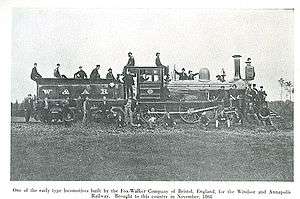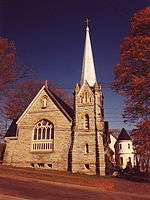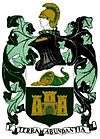Windsor, Nova Scotia
| Windsor, Nova Scotia | |||
|---|---|---|---|
| Town | |||
| |||
| Nickname(s): Birthplace of Hockey | |||
|
Motto: "E Terra Abundantia" (Latin) "Abundant Eastern Land" | |||
 Windsor, Nova Scotia Location within Nova Scotia | |||
| Coordinates: 44°58′49″N 64°7′45″W / 44.98028°N 64.12917°WCoordinates: 44°58′49″N 64°7′45″W / 44.98028°N 64.12917°W | |||
| Country |
| ||
| Province |
| ||
| Municipality | Hants County | ||
| Founded | 1685 | ||
| Incorporated | April 4, 1878 | ||
| Government | |||
| • Mayor | Anna Allen | ||
| • Governing Body | Windsor Town Council | ||
| • MLA | Chuck Porter Liberal (L) | ||
| • MP | Scott Brison (L) | ||
| Area | |||
| • Total | 9.06 km2 (3.50 sq mi) | ||
| Highest elevation | 32 m (105 ft) | ||
| Lowest elevation | 0 m (0 ft) | ||
| Population (2011) | |||
| • Total | 3,785 | ||
| • Density | 417.8/km2 (1,082/sq mi) | ||
| Time zone | AST (UTC-4) | ||
| Postal code | B0N 2T0 | ||
| Area code(s) | 902 | ||
| Telephone Exchanges | 306 321 472 790 791 792 798 799 | ||
| Median Earnings* | $24,502 | ||
| NTS Map | 021A16 | ||
| GNBC Code | CBPAK | ||
| Website | windsor.ns.ca | ||
| *Median household income, 2000 ($) (all households) | |||
Windsor (2011 population: 3,785) is a Canadian town located in Hants County, Nova Scotia. It is a service centre for the western part of the county and is situated on Highway 101.
The town has a history dating back to its use by the Mi'kmaq Nation for several millennia prior to European discovery. When the Acadians lived in the area, the town was raided by New England forces in 1704. The area was central to both Father Le Loutre's War and the Expulsion of the Acadians during the Bay of Fundy Campaign in 1755. The town promotes itself as the birthplace of ice hockey and was the home of Canada's first internationally best-selling author, Thomas Chandler Haliburton.
History
| Historical population | ||
|---|---|---|
| Year | Pop. | ±% |
| 1881 | 2,559 | — |
| 1891 | 2,838 | +10.9% |
| 1901 | 3,398 | +19.7% |
| 1911 | 3,452 | +1.6% |
| 1921 | 2,946 | −14.7% |
| 1931 | 3,032 | +2.9% |
| 1941 | 3,436 | +13.3% |
| 1951 | 3,439 | +0.1% |
| 1956 | 3,651 | +6.2% |
| 1961 | 3,823 | +4.7% |
| 1981 | 3,646 | −4.6% |
| 1986 | 3,665 | +0.5% |
| 1991 | 3,625 | −1.1% |
| 1996 | 3,726 | +2.8% |
| 2001 | 3,778 | +1.4% |
| 2006 | 3,709 | −1.8% |
| 2011 | 3,785 | +2.0% |
| [1][2][3][4] [5][6][7] | ||
Having migrated from Port Royal, Nova Scotia, the Acadians were the first to settle in Pisiguit by the early 1680s. French census records dated 1686 list well established farms utilizing dyked marshlands.
Queen Anne's War
Raid on Pisiquid (1704)
During Queen Anne's War, in response to the Wabanaki Confederacy of Acadia military campaign against the New England frontier and the Canadian Raid on Deerfield, Massachusetts, Benjamin Church led the Raid on Pisiquid (1704) and burned the village to the ground. In the Raid on Pisiquid, Church burned 40 houses along with out-buildings, crops and cattle. There was resistance and two Mi’kmaq were wounded.[8]
Father Le Loutre's War

Despite the British Conquest of Acadia in 1710, Nova Scotia remained primarily occupied by Catholic Acadians and Mi'kmaq. Father Le Loutre's War began when Edward Cornwallis arrived to establish Halifax with 13 transports on June 21, 1749.[9] By unilaterally establishing Halifax the British were violating earlier treaties with the Mi'kmaq (1726), which were signed after Dummer's War.[10] The British quickly began to build other settlements. To guard against Mi'kmaq, Acadian and French attacks on the new Protestant settlements, British fortifications were erected in Halifax (1749), Dartmouth (1750), Bedford (Fort Sackville) (1751), Lunenburg (1753) and Lawrencetown (1754).[11]
Within 18 months of establishing Halifax, the British also took firm control of peninsula Nova Scotia by building fortifications in all the major Acadian communities: present-day Windsor (Fort Edward); Grand Pre (Fort Vieux Logis) and Chignecto (Fort Lawrence). (A British fort already existed at the other major Acadian centre of Annapolis Royal, Nova Scotia. Cobequid remained without a fort.)[11] Many Acadians left this region in the Acadian Exodus, which preceded the Expulsion of the Acadians.
French and Indian War
During the French and Indian War, Fort Edward and Windsor played a significant role in the deportation, particularly the Bay of Fundy Campaign (1755). Acadians were imprisoned in the fort as they were notified about the expulsion. Acadians numbering in the thousands were deported from mainland Nova Scotia. The deportees frequently were held onboard ships for several weeks before being moved to their destinations, thus exacerbating unhealthy conditions below decks and leading to the deaths of hundreds. Many hundreds more were lost through ship sinkings and disease onboard ships while en route to ports in Britain's American colonies, Britain, and France. The British also broke apart families and sent them to different places. Their justification for this was to more efficiently put people on the boats. This resulted in more loss of life as families could not survive without essential members.[12]
New England Planters
The Township of Windsor was founded in 1764 by New England Planters. The next year, its first Agricultural Fair was held. This fair is still continued today, and is the oldest and longest-running such fair in North America.
American Revolution
In the American Revolution, Windsor was an important British stronghold. Fort Edward was the headquarters in Atlantic Canada for 84th Regiment of Foot (Royal Highland Emigrants). A relief force was mustered at Windsor to crush the American-led siege at the Battle of Fort Cumberland in 1776.
Loyalists
Following the American Revolution, Windsor was settled by United Empire Loyalists.
Plaster War
Windsor developed its gypsum deposits, usually selling it to American markets at Passamaquoddy Bay. Often this trade was illegal; in 1820, an effort to stop this smuggling trade resulted in the "Plaster War," in which local smugglers resoundingly defeated the efforts of New Brunswick officials to bring the trade under their control.[13]
Kings
The University of King's College and its secondary school, King's Collegiate School, were founded in 1788-1789 by United Empire Loyalists as Anglican academic institutions. The college remained in the community until a disastrous fire on February 3, 1920. In 1922 it moved to Halifax, with the assistance of the Carnegie Foundation and continues to this day.
The King's Collegiate School continued operation on the campus and was joined by a sister girls school, 'Edgehill School', in 1890. In 1976 both institutions merged to form King's-Edgehill School, and remains the oldest independent (i.e. private) school in the Commonwealth outside of the United Kingdom.
Haliburton
Thomas Chandler Haliburton brought fame to Windsor during the 19th century with his writings about a clockmaker named Sam Slick.
Ships, rail and roads

In 1878, Windsor was officially incorporated as a town. Its harbour made the town a centre for shipping and shipbuilding during the age of sail. Notable shipbuilders such as Bennett Smith built a large fleet of merchant vessels, one of the last being the ship Black Watch. As the port of registry for the massive wooden shipbuilding industry of the Minas Basin, Windsor was the homeport of one of the largest fleet of sailing ships in Canada. Notable vessels registered at Windsor included Hamburg, the largest three masted barque built in Canada and Kings County, the largest four masted barque. Following the completion of the Nova Scotia Railway's line from Halifax in 1857, the town became an important steamship connection giving Halifax access to the Bay of Fundy shipping routes. The railway continued westward as the Windsor and Annapolis Railway in 1870, eventually connecting to Yarmouth as the Dominion Atlantic Railway in 1893. In 1901 the Midland Railway was built across Hants County, connecting Windsor with Truro.
No longer the railhead, Windsor's steamship connection diminished but the central location of Windsor on the railway fostered the growth of numerous factories such as textile mills, fertilizer plants and furniture factories. The home of one of the industrialist families of this era, the Shands, is preserved today in Windsor as the Shand House Museum.
Over the course of its history, Windsor was victim to two disastrous fires, on October 17, 1897, and January 6, 1924, both of which destroyed part of the town.
In 1970, the construction of a flood-control causeway carrying Highway 101 and the Dominion Atlantic Railway across the Avon River closed Windsor off from shipping and has affected navigation in the Avon River downstream from the causeway due to excessive siltation. Highway 101 is scheduled to be upgraded to a 4-lane expressway in the future and there have been discussions about replacing the causeway with a railroad and highway bridges to improve water flow. Today, the Avon River on the upstream side of the causeway which is obstructed from freely flowing into the Bay of Fundy is called 'Lake Pisiquid'.
Geography
Situated at the junction of the Avon and St. Croix Rivers, it is the largest community in the District of the Municipality of West Hants and had a 2001 population of = 3,779 residents. Prior to the county being divided into separate municipal districts, Windsor had served as the shire town of the county. The region encompassing present day Windsor was originally part of Pisiguit, a Mi'kmaq term meaning "Junction of Waters". This name referred to the confluence of the Avon and St. Croix rivers, which flow into the Minas Basin.
Climate
The highest temperature ever recorded in Windsor was 37.8 °C (100 °F) on 19 August 1935.[14] The coldest temperature ever recorded was −32.5 °C (−26.5 °F) on 7 February 1993.[15]
| Climate data for Windsor (Martock), 1981–2010 normals, extremes 1871–2005 | |||||||||||||
|---|---|---|---|---|---|---|---|---|---|---|---|---|---|
| Month | Jan | Feb | Mar | Apr | May | Jun | Jul | Aug | Sep | Oct | Nov | Dec | Year |
| Record high °C (°F) | 18.5 (65.3) |
19.5 (67.1) |
27.0 (80.6) |
28.5 (83.3) |
34.0 (93.2) |
35.6 (96.1) |
35.0 (95) |
37.8 (100) |
34.0 (93.2) |
30.0 (86) |
22.0 (71.6) |
17.5 (63.5) |
37.8 (100) |
| Average high °C (°F) | −1.0 (30.2) |
0.2 (32.4) |
4.0 (39.2) |
10.1 (50.2) |
17.1 (62.8) |
22.1 (71.8) |
25.5 (77.9) |
25.1 (77.2) |
20.6 (69.1) |
14.2 (57.6) |
8.0 (46.4) |
2.4 (36.3) |
12.4 (54.3) |
| Daily mean °C (°F) | −5.5 (22.1) |
−4.4 (24.1) |
−0.6 (30.9) |
5.3 (41.5) |
11.3 (52.3) |
16.2 (61.2) |
19.9 (67.8) |
19.5 (67.1) |
15.2 (59.4) |
9.4 (48.9) |
4.2 (39.6) |
−1.6 (29.1) |
7.4 (45.3) |
| Average low °C (°F) | −9.9 (14.2) |
−9.1 (15.6) |
−5.2 (22.6) |
0.4 (32.7) |
5.5 (41.9) |
10.3 (50.5) |
14.2 (57.6) |
13.9 (57) |
9.8 (49.6) |
4.6 (40.3) |
0.3 (32.5) |
−5.6 (21.9) |
2.4 (36.3) |
| Record low °C (°F) | −29.4 (−20.9) |
−32.5 (−26.5) |
−23.9 (−11) |
−13.9 (7) |
−5.0 (23) |
−2.2 (28) |
3.3 (37.9) |
0.0 (32) |
−2.5 (27.5) |
−7.8 (18) |
−16.7 (1.9) |
−25.0 (−13) |
−32.5 (−26.5) |
| Average precipitation mm (inches) | 147.1 (5.791) |
107.2 (4.22) |
126.1 (4.965) |
103.3 (4.067) |
95.3 (3.752) |
82.8 (3.26) |
83.9 (3.303) |
76.3 (3.004) |
105.6 (4.157) |
108.8 (4.283) |
143.6 (5.654) |
129.7 (5.106) |
1,309.6 (51.559) |
| Average rainfall mm (inches) | 71.9 (2.831) |
54.6 (2.15) |
83.2 (3.276) |
88.6 (3.488) |
93.7 (3.689) |
82.8 (3.26) |
83.9 (3.303) |
76.3 (3.004) |
105.9 (4.169) |
108.8 (4.283) |
127.0 (5) |
84.0 (3.307) |
1,060.2 (41.74) |
| Average snowfall cm (inches) | 75.2 (29.61) |
52.6 (20.71) |
42.9 (16.89) |
14.7 (5.79) |
1.6 (0.63) |
0.0 (0) |
0.0 (0) |
0.0 (0) |
0.0 (0) |
0.0 (0) |
16.6 (6.54) |
45.7 (17.99) |
249.4 (98.19) |
| Source: Environment Canada[14][15][16] | |||||||||||||
Town Attractions
Windsor, NS is home to numerous attractions beginning with the claim to being the birth place of hockey. Windsor is home to both the Cradle of Hockey which is home to Long Pond where hockey began beside Howard Dill's Farm. The town of Windsor is also home to the oldest agricultural fair in North America which is held on two separate weekends in September.[17] The first fair was held in Windsor in the year 1765 making their 250th anniversary in 2015.[17]

Ice hockey
Windsor maintains a claim as the birthplace of hockey, based upon a reference (in a novel by Thomas Haliburton) of boys from King's Collegiate School playing "hurley", on the frozen waters of 'Long Pond' adjacent to the school's campus during the early 19th century.[18] Students from King's-Edgehill School still play hockey on "Long Pond", a pond proclaimed by some as the "Cradle of Hockey", located at the farm of Howard Dill. Windsor also boasts the oldest hockey arena in Canada, the Stannus Street Rink, which no longer hosts hockey games. The town's current arena is Hants Exhibition Arena. The town was also recently involved in the shooting of a television series called Road Hockey Rumble. The town of Windsor was also home to the historic Windsor Royals Jr. B Hockey Club, as well as the Avon River Rats Jr. C Hockey Club. The Windsor Royals Jr. B club ceased playing in the spring of 2012.
Surrounding area
Windsor is 66 km northwest of Halifax, approximately 20 km from the eastern end of the Annapolis Valley. Windsor used to be a railway junction for the Dominion Atlantic Railway where a route to Truro joined with the mainline between Halifax and Yarmouth. The community of Falmouth, Nova Scotia and town of Hantsport are located a few kilometres to the west.
Today the community is a local service centre and nucleus of the West Hants Municipal District.
Fundy Gypsum, a mining company operating gypsum mines just east of town, was a major employer in the region. The gypsum company closed in 2011, costing hundreds of jobs. Southwestern Nova Scotia's only alpine ski hill is located 3 km up the Avon River valley from Windsor at Martock. It is home to the Windsor Pumpkin Regatta.
Windsor is also home to the Mermaid Theatre of Nova Scotia. The theatre supports a touring troupe, which performs locally and internationally, as well as many children's theatre programs.
 St. John's Roman Catholic Church, designed by William Critchlow Harris
St. John's Roman Catholic Church, designed by William Critchlow Harris Hants Community Hospital
Hants Community Hospital
Pumpkin Regatta
The world's very first pumpkin regatta was held in Windsor in 1999 where people carve out the giant pumpkins and race across lake Pisiquid.[17] The regatta now includes a motorized class where a motor is attached to the pumpkin with a floatation device.[17]
Notable residents
- Thomas R. Bennett
- Scott Brison
- George Elliott Clarke
- Rufus Curry
- Amor De Cosmos
- Benjamin DeWolf (Windsor merchant)
- George Henry Emerson (Twillingate and Fogo)
- James Fraser (businessman)
- Sir Charles Frederic Fraser
- Henry Goudge
- Monson Henry Goudge (son)
- Allen Haley
- Thomas Chandler Haliburton
- Lewis Herbert Martell
- Richard McHeffy
- Alden Nowlan (from nearby Stanley, Nova Scotia)
- Percy Paris
- Daniel McNeill Parker
- Silas Tertius Rand
- Gerald Regan
- Geoff Regan
- Avon Saxon
- Jennifer Rosanne States
- Charlotte Elizabeth Tonna
- Peter Togni
- Benjamin Wier (nearby Brooklyn)
- Charles Smith Wilcox
- Lewis Morris Wilkins (speaker)
- Lewis Morris Wilkins (son)
Municipal government
The town operates under a Council/Manager system of local government consisting of current elected Mayor Paul Beazley, current Deputy Mayor Laurie Murley, three elected Councillors, Dave Sealey, Liz Galbraith, and John Bergante and a Chief Administrative Officer, Louis Coutinho.
Parks
- Falls Lake Provincial Park
- Victoria Park
- Windsor Playland Park
- Windsor Waterfront Skatepark
See also
- List of municipalities in Nova Scotia
- King's-Edgehill School
- University of King's College
- The Hants Journal
References
Texts
Endnotes
- ↑ Census 1881-1901
- ↑ , Censuses 1871-1931
- ↑ , Census 1941-1951
- ↑ Census 1956-1961
- ↑ , Census 1961
- ↑ , Censuses 1981-2001
- ↑ I:\ecstats\Agency\BRIAN\census2
- ↑ Boston News-Letter No. 16, Mon. July 31 – Mon. Aug. 7, 1704, p. 2
- ↑ Grenier, John. The Far Reaches of Empire. War in Nova Scotia, 1710-1760. Norman: U of Oklahoma P, 2008; Thomas Beamish Akins. History of Halifax, Brookhouse Press. 1895. (2002 edition). p 7
- ↑ Wicken, p. 181; Griffith, p. 390; Also see http://www.northeastarch.com/vieux_logis.html
- 1 2 John Grenier. The Far Reaches of Empire: War in Nova Scotia, 1710-1760. Oklahoma University Press.
- ↑ See Stephan Bujold (2004). L'Acadie vers 1550: Essai de chronologie des paroisses acadiennes du bassin des Mines (Minas Basin, NS) avant le Grand derangement. SCHEC Etudes d'histoire religieuse, 70 (2004), 59-79.
- ↑ Smith, Joshua (2007). Borderland Smuggling: Patriots, Loyalists, and Illicit Trade in the Northeast, 1780-1820. Gainesville, FL: UPF. pp. passim. ISBN 0-8130-2986-4.
- 1 2 "August 1935". Canadian Climate Data. Environment Canada. Retrieved 26 June 2016.
- 1 2 "Windsor". Canadian Climate Normals 1981–2010 (in English and French). Environment Canada. Retrieved September 12, 2015.
- ↑ "Windsor Kings College". Canadian Climate Data. Environment Canada. Retrieved 26 June 2016.
- 1 2 3 4 "Visitors - Town of Windsor, N.S.". www.town.windsor.ns.ca. Retrieved 2016-12-02.
- ↑ birthplace of hockey
External links
Further reading
- Joshua M. Smith, Borderland Smuggling: Patriots, Loyalists, and Illicit Trade in the Northeast, 1783-1820 (Gainesville: University Press of Florida, 2006).
- Garth Vaughan, The Puck stops Here: The origin of Canada's great game - Ice Hockey, (Goose Lane Editions, 1996)

